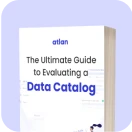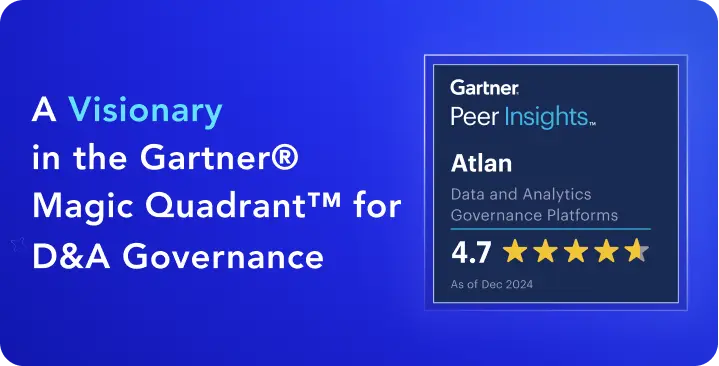AI Governance Framework: Why It’s Indispensable for Successful AI Projects
Share this article
Two out of every three companies have adopted AI into their operations, according to a recent McKinsey study. This AI boom, however, is creating a governance crisis: 96% of firms leveraging AI say they find governing AI systems a challenge.
See How Atlan Simplifies Data Governance – Start Product Tour
AI governance ensures your organization is using AI securely, responsibly, and with accountability as an integral part of your decision-making framework. Without a proper AI governance framework, odds are slim that your AI ambitions will go smoothly — or even make it into production at all.
In this article, we’ll outline what an AI governance framework is, the value it provides, and what tools you need to support it.
Table of contents #
- What is an AI governance framework?
- Why do I need an AI governance framework?
- The elements of an effective AI governance framework
- The interplay of data governance tools and AI governance frameworks
- Conclusion
- Related reads
What is an AI governance framework? #
An AI governance framework consists of a collection of policies, tools, and practices that specify decision rights and accountability for the use of AI. Frameworks not only address data governance for AI systems; they also encompass the unique issues and risks organizations face when adopting generative AI.
Frameworks use the six pillars of AI governance to promote responsible use of artificial intelligence technologies:
People: The people, groups, and roles within the organization, such as executive sponsors, oversight boards, and stewards, that are responsible for and who participate in AI governance.
Process: The framework itself, including its components and controls.
Technology: Every software component involved in the AI process (cloud platforms, Large Language Models, AI development platforms and training pipelines, etc.), as well as software for managing governance and responsible use (data catalog, data governance platforms).
Regulations: All applicable existing data governance regulations (e.g., GDPR, the California Consumer Privacy Act), as well as globally emerging AI legislation like the EU Artificial Intelligence Act, the US White House Executive Order on AI, and the China Deepfakes Law.
Industry standards: Industry-specific regulations or voluntary frameworks, such as those established by the AI Verify Foundation.
End-to-end use case analysis: Review of a specific AI implementation to ensure the framework has been applied properly.
Why do I need an AI governance framework? #
AI’s potential benefits are enormous. But, like any emerging technology, it also presents some novel challenges. When your company is embracing AI at any level of operations, a governance framework helps you successfully navigate these AI adoption challenges:
Compliance: Regulations around AI ethics, data privacy, and transparency continue to evolve and tighten globally. Governance frameworks help you stay in compliance with legal and industry standards. Without one, you may face significant operational, reputational, and financial risks.
Novel risks: AI systems can lead to unintended consequences, such as biased decisions, data misuse, or security vulnerabilities. Governance ensures that your organization can proactively identify and manage these risks.
Transparency and trust: Governance frameworks establish processes for AI development and deployment, enhancing transparency for customers, regulators, and stakeholders.
Scalability and consistency: With AI integrated across departments, governance ensures a consistent approach to AI management, reducing inefficiencies or conflicting practices.
What are the risks of using AI without governance? #
Adopting AI without a robust AI governance framework carries significant risks:
Regulatory violations: Without a clearly defined framework for AI governance, your company could find itself in violation of the law without even knowing it, risking hefty fines and reputational damage as a result. As an example, in 2022 the French SA fined Clearview AI a total of €20 million for failing to implement controls in their system to comply with user requests for the erasure of personal data — a violation of GDPR.
Data security breaches: Without the oversight, monitoring, and safeguards provided by an AI governance framework, an AI system might mishandle or expose sensitive data.
Erosion of customer trust: Misaligned AI applications (e.g., intrusive recommendations, privacy violations) can alienate customers.
Inconsistent interpretations. The lack of a framework can lead different teams to interpret AI guidelines and regulations in divergent— and possibly incorrect — ways. Teams can end up releasing systems they believe to be safe and secure, but that actually contain vulnerabilities or are not in compliance.
Missed opportunities: Lack of governance creates inefficiencies, delays, and mistrust, reducing the effectiveness of AI investments.
The benefits of AI governance framework #
On the positive side, having an AI governance framework can confer organizational and business benefits upon your organization. These benefits include:
Streamlined implementation. Implementing a governance framework — including the tools that support it — makes it easier for all teams in a company to develop solutions that are secure and compliant by default.
Improved decision making: AI governance establishes clear guidelines for how AI is used in your org. It helps ensure that your AI models are reliable, explainable, and aligned with organizational goals, and that their outputs are accurate, interpretable, and actionable.
Improved trust. Knowing that your data and systems are appropriately governed improves trust, and trust improves adoption as well as confidence in the underlying data.
Enhanced accountability: A governance framework helps clarify the roles and responsibilities needed for AI development and deployment in your organization
Enhanced consistency and collaboration: When everyone is following the same governance playbook, it makes it easier for teams to work together and share data across projects.
The elements of an effective AI governance framework #
What goes into an effective AI governance framework? A comprehensive new book by Sunil Soares, AI Governance Comprehensive: Tools, Vendors, Controls and Regulations, defines 13 components of AI governance, that every framework should implement:
- Establish accountability for AI
- Assess regulatory risks
- Gather inventory of use cases
- Increase value of underlying data
- Assess fairness and accessibility
- Improve reliability and safety
- Heighten transparency and explainability
- Implement accountability with human-in-the-loop
- Support privacy and retention
- Improve security
- Implement AI model lifecycle and registry
- Manage risk
- Realize AI value
Let’s look at each one of these elements in turn.
Establish accountability for AI #
Accountability means appointing the right people — e.g., an executive sponsor, an AI governance leader, an oversight board — as well as creating an overall AI strategy. It’s also important that everyone in the organization agrees on the definition of “AI” and that the organization’s AI policy is available and accessible to all pertinent parties.
Assess regulatory risks #
With jurisdictions worldwide passing their own AI regulations, it’s critical to identify which are applicable to your initiatives and map them to the appropriate controls. You will also need to identify the relevant data privacy, intellectual property, and competition value realization regulation laws, as well as any laws specific to your industry (e.g., HIPAA for health care in the US).
Gather inventory of use cases #
Different divisions within your organization will utilize AI for different purposes. Discover and document all applicable use cases, such as:
- Code generation
- Marketing automation
- Product page personalization
- Customer service co-pilot/chatbot
- Fraud detection and analytics
Next, for each use case, identify and document the business justification, cost drivers, and expected return on investment. This enables you to assess whether your investment in AI technology yields the expected dividends.
Increase the value of underlying data #
Assess the value of your data. This includes:
- Applying traditional finance methodologies, such as discounted cash flows, to evaluate the value of your data
- Using factors such as data quality metrics to assess overall data quality, which has a significant impact on your data’s value
- Determining what rights you have to use your data, which will determine what business value you can extract from it
- Ensuring data is properly classified so that sensitive information isn’t inadvertently used in techniques such as Retrieval-Augmented Generation (RAG)
You can increase the value of your AI data by ensuring it’s aligned with your overall data governance strategy. Data used for AI should adhere to the same controls and quality metrics you’ve already established for all other data use cases within your organization.
Address fairness and accessibility #
Harmful bias happens when AI generates answers based on prejudicial data, including hateful or discriminatory data in the original data set, and can seriously undermine trust in your AI apps both internally and with customers. To guard against bias,
- Perform a bias audit to detect and eliminate systemic, computational, and human-cognitive biases from your data sets.
- Ensure accessibility — i.e., ensure that your solution meets the needs of people with disabilities - by supporting multiple methods to render content (e.g., generating ALT text for images for blind or visually impaired users).
Improve reliability and safety #
AI’s infamous hallucination problems may make users skeptical about using AI-driven apps. Worse, they can result in negative outcomes if users follow flawed or even hazardous advice generated by an AI. Unless strictly monitored, interactive AI agents, such as chatbots, can also engage in behavior that crosses ethical boundaries (e.g., an exercise assistant that urges someone to work out past their physical limitations).
- Regularly assess the quality of your AI models and supporting data through rigorous testing.
- Additionally, audit your systems to ensure they avoid engaging in malign, manipulative, or coercive behavior.
Heighten transparency and explainability #
The rise of “deep fakes” on the Internet has resulted in new forms of fraud and misinformation. As a result, more countries are passing laws requiring that AI-generated content be labeled as such.
- Adopt a credentialing or provenance standard that makes it clear who created an AI-generated asset.
- You should also provide explainability and interpretability mechanisms to help human operators understand how an AI app arrived at its conclusions.
Implement accountability with human-in-the-loop #
You can eliminate many of the fears connected to “AI run amok” by ensuring humans retain control.
- Human-in-the-loop (HITL) feedback mechanisms, enable AI stewards and operators to fine-tune AI responses, combining automated data analysis with human intelligence and intuition.
Support privacy and retention #
Minimize and anonymize data to prevent sensitive customer information from being leaked publicly.
- Where possible, use synthetically generated data, which echoes real-world data mathematically without incurring the risks of exposing an actual person’s personally identifiable information (PII) on the Internet.
- Additionally, ensure that your AI data complies with all data privacy and retention policies applicable in your area.
Improve security #
AI systems are subject to unique security compromises. In “ jailbreaking” (a.k.a. prompt injection), for example, a user prompts an LLM or AI system to bypass its security safeguards. Other types of attacks attempt to compromise an AI’s base data. For example, data and model poisoning attacks inject misinformation into source data sets on which the AI is known to be trained.
- Developers need to take care that generative AI agents (natural language interfaces, like ChatGPT) can’t be compelled to engage in illicit activities such as large-scale spear-phishing email attacks or software vulnerability discovery.
Implement AI model lifecycle and registry #
Regulations such as the EU AI Act require documenting the flow of AI data at various stages of the data lifecycle - e.g., data acquisition, modeling, model deployment, and monitoring.
- Businesses also need to maintain an active registry of all running AI applications along with their business owner and other responsible parties.
- Companies need to document their pre-release testing and maintain adequate logs of events, such as who verified a result.
Manage risk #
Risk management identifies and mitigates threats and uncertainties that can affect a company and its users.
Risk management is especially important for AI applications, as the EU AI Act deems a certain class of applications—e.g., safety products, biometrics, law enforcement, and other use cases—as high-risk AI systems. Such systems must complete a formal registration process before deployment in the European Union.
- Organizations should classify all their uses of AI according to risk, identifying high-risk AI systems and weeding out prohibited uses (e.g., social scoring). High-risk systems will require AI governance impact assessments and possibly a third-party risk assessment.
- Adopt a rigorous quality management system. This should take the form of an AI governance playbook that covers testing, documentation, risk management, and post-market monitoring of AI solutions.
Realize AI value #
To ensure you’re making the best investments, prioritize AI use cases based on value, spend, and risk.
- Implement pilot use cases at a small scale and expand their deployment as you vet your original assumptions.
- To realize the most value across a corporation, Gartner suggests setting up a centralized AI Center of Excellence that can collaborate with bottom-up initiatives, assisting local teams with expertise, technology, and governance. This hybrid approach enables AI initiatives to get to market quickly while also ensuring efficiency and oversight.
The interplay of data governance tools and AI governance frameworks #
While AI governance is a distinct discipline, it relies heavily on a strong foundation of data governance. Data governance focuses on the trustworthiness and responsible handling of data, and these are also cornerstones of successful AI governance.
Atlan is a data management platform that supports active data governance for the AI age. Atlan can support your AI governance framework by:
- Accelerating data government through automation and AI features, such as playbooks for common data governance tasks and AI recommendations for metadata
- Offering accountability and traceability for your AI data sets through data lineage, which shows the flow of data it takes as it traverses your company
- Providing a central control panel for creating AI-assisted data policies, approving exceptions, and managing incidents
Ask for a demo today to learn more about how Atlan can help you lay the foundation of a solid AI governance framework.
AI Governance Framework: Related reads #
- GMLP: An Essential Guide for Medical Device Manufacturers in 2025
- Elvis Act: What Is It & How To Ensure Compliance In 2025
- The EU AI Act: What does it mean for you?
- Data Readiness for AI: 4 Fundamental Factors to Consider
- AI Governance for Healthcare: Benefits and Usecases
- Role of Metadata Management in Enterprise AI: Why It Matters
- AI Governance: How to Mitigate Risks & Maximize Business Benefits
- Gartner on AI Governance: Importance, Issues, Way Forward
- Data Governance for AI
- AI Data Governance: Why Is It A Compelling Possibility?
- BCBS 239 2025: Principles for Effective Risk Data Management and Reporting
- BCBS 239 Compliance: What Banks Need to Know in 2025
- BCBS 239 Data Governance: What Banks Need to Know in 2025
- BCBS 239 Data Lineage: What Banks Need to Know in 2025
- HIPAA Compliance: Key Components, Rules & Standards
- CCPA Compliance: 7 Requirements to Become CCPA Compliant
- CCPA Compliance Checklist: 9 Points to Be Considered
- How to Comply With GDPR? 7 Requirements to Know!
- Benefits of GDPR Compliance: Protect Your Data and Business in 2025
- IDMP Compliance: It’s Key Elements, Requirements & Benefits
- Data Governance for Banking: Core Challenges, Business Benefits, and Essential Capabilities in 2025
- Data Governance in Action: Community-Centered and Personalized
- Data Governance Framework — Examples, Templates, Standards, Best practices & How to Create One?
- Data Governance Tools: Importance, Key Capabilities, Trends, and Deployment Options
- Data Governance Tools Comparison: How to Select the Best
- Data Governance Tools Cost: What’s The Actual Price?
- Data Governance Process: Why Your Business Can’t Succeed Without It
- Data Governance and Compliance: Act of Checks & Balances
- Data Governance vs Data Compliance: Nah, They Aren’t The Same!
- Data Compliance Management: Concept, Components, Getting Started
- Data Governance for AI: Challenges & Best Practices
- A Guide to Gartner Data Governance Research: Market Guides, Hype Cycles, and Peer Reviews
- Gartner Data Governance Maturity Model: What It Is, How It Works
- Data Governance Roles and Responsibilities: A Round-Up
- Data Governance in Banking: Benefits, Implementation, Challenges, and Best Practices
- Data Governance Maturity Model: A Roadmap to Optimizing Your Data Initiatives and Driving Business Value
- Open Source Data Governance - 7 Best Tools to Consider in 2025
- Federated Data Governance: Principles, Benefits, Setup
- Data Governance Committee 101: When Do You Need One?
- Data Governance for Healthcare: Challenges, Benefits, Core Capabilities, and Implementation
- Data Governance in Hospitality: Challenges, Benefits, Core Capabilities, and Implementation
- 10 Steps to Achieve HIPAA Compliance With Data Governance
- Snowflake Data Governance — Features, Frameworks & Best practices
- Data Governance Policy: Examples, Templates & How to Write One
- 7 Best Practices for Data Governance to Follow in 2025
- Benefits of Data Governance: 4 Ways It Helps Build Great Data Teams
- Key Objectives of Data Governance: How Should You Think About Them?
- The 3 Principles of Data Governance: Pillars of a Modern Data Culture
Share this article











